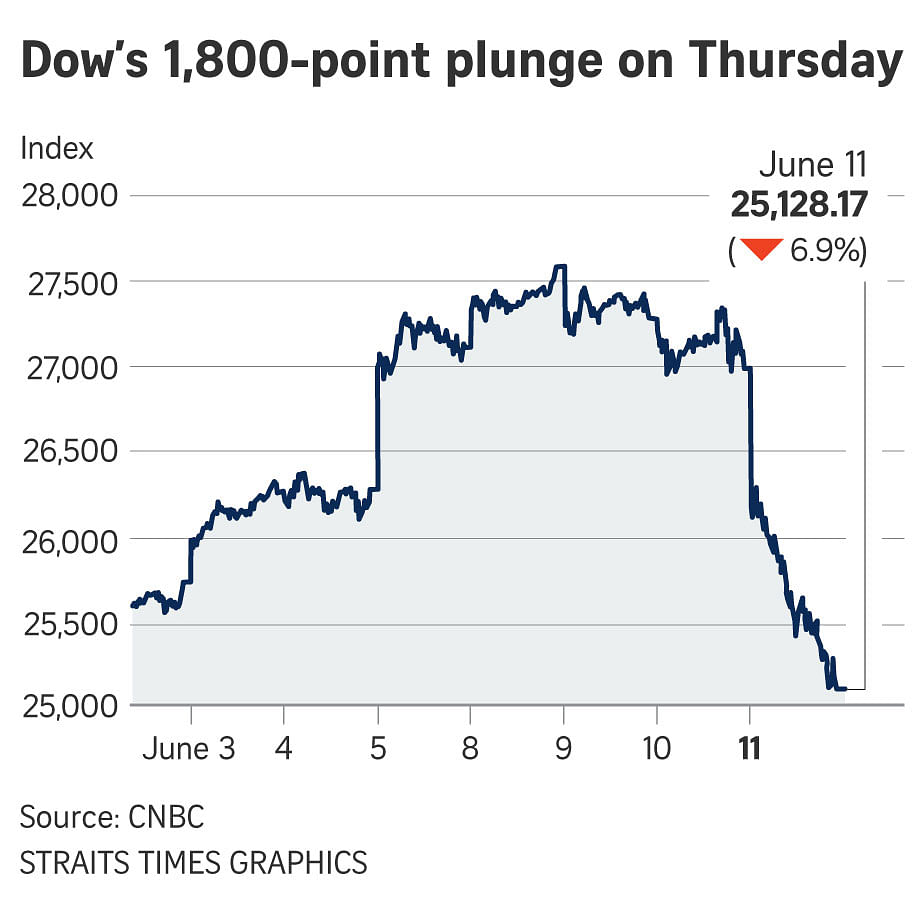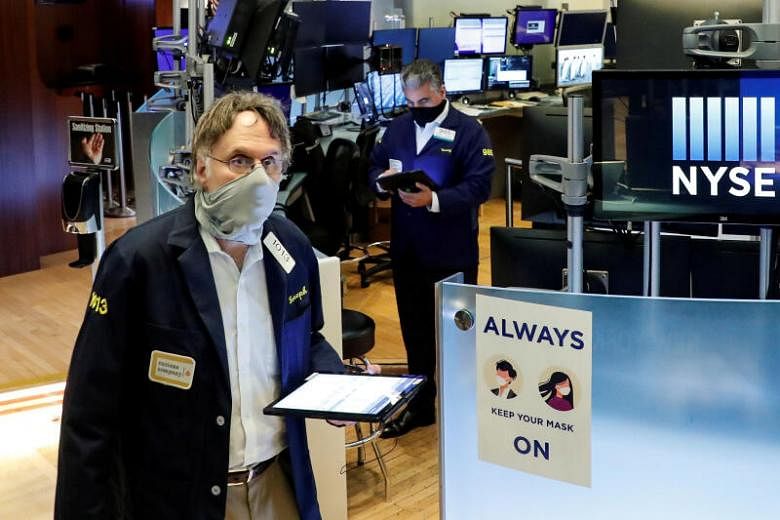NEW YORK (REUTERS) - Global equity markets fell sharply on Thursday (June 11) in their worst sell-off since markets crashed in March after a resurgence of coronavirus infections in the United States and the Federal Reserve's sobering outlook cast doubt on hopes for a V-shaped economic recovery.
A broad rout slammed Wall Street, snuffed a 10-day winning streak in Asia and plunged major European bourses about 4 per cent, to halt a recent rally that had recouped much of the market's deep losses and even drove the Nasdaq to record highs this week.
In a reality check to the stock market's recent euphoria, the Fed predicted the US economy would shrink 6.5 per cent in 2020 and unemployment would still be at 9.3 per cent at year's end.
Stocks on Wall Street fell more than 5 per cent as declining issues outnumbered advancing ones on the New York Stock Exchange by a ratio of almost 18:1, while the ratio was about 13:1 on Nasdaq.
The Dow Jones Industrial Average fell 1,861.82 points, or 6.9 per cent, to 25,128.17. The S&P 500 lost 188.04 points, or 5.89 per cent, to 3,002.1 and the Nasdaq Composite dropped 527.62 points, or 5.27 per cent, to 9,492.73.
MSCI's all-country world index, which tracks shares in 49 nations, fell 4.78 per cent to 513.94, its biggest slide since March 18, when it declined 5.1 per cent. Europe's broad FTSEurofirst 300 index closed down 4.11 per cent at 1,378.16.
Earlier on Thursday in Asia, Singapore led major markets sharply lower with the Straits Times Index closing down 3.4 per cent.
Japan's Nikkei index plunged 2.8 per cent while Hong Kong's Hang Seng Index tumbled 2.3 per cent and the Shanghai Composite Index fell 0.8 per cent. Australia's S&P/ASX 200 index tumbled 3.1 per cent while South Korea's Kospi index dropped 0.9 per cent.
The number of Americans seeking jobless benefits fell last week, but millions laid off due to the pandemic continue to receive unemployment checks, suggesting the US labor market could take years to heal even as hiring resumes.
The Fed is not painting a perfect V-shaped recovery and is going to be ultra-accommodative for a very long time, said Esty Dwek, head of global market strategy at Natixis Investment Managers in Geneva. A V-shaped recovery refers to a sharp economic resurgence following a sharp decline.
"Suddenly the question is, 'Well, why are they going to be so accommodative if the recovery is going so well?'" she said.
Some of the sell-off "is probably just by not being the V-shape the market is priced for right now, and some of it is taking a breather after the last few weeks," Dwek said.
Fed chair Jerome Powell at the end of a two-day meeting of policymakers confirmed the Fed was studying yield curve control, a form of easing already employed by Japan and Australia.
John Vail, chief global strategist at Nikko Asset Management in Tokyo, said in his view the Fed is moving toward yield curve control, which should keep 10-year yields at 1 per cent or less and will tend to suppress the dollar, at least for a while.
US Treasury and euro zone government bonds rallied after the Fed on Wednesday signaled it plans years of extraordinary support to counter the economic fallout from a pandemic that is still spreading and still has no cure or vaccine.
US gold futures settled more than 1 per cent higher and the dollar, yen and Swiss franc all benefited from safe-haven flows as Wall Street slumped.
The yen rose to a one-month high against the dollar, while the Swiss franc climbed to a three-month peak. The dollar also rose 0.4 per cent to 96.556, against a basket of currencies.
The euro fell 0.63 per cent to US$1.1297, and the yen slid 0.22 per cent to US$106.8500.
Yields on 10-year Treasury notes dropped sharply from last week's peak of 0.96 per cent. The 10-year Treasury note fell 8.6 basis points to yield 0.6625 per cent, while Germany's 10-year benchmark fell 10 basis points to a nine-day low at -0.43 per cent.
US gold futures settled up 1.1 per cent at US$1,739.80 an ounce.
SECOND WAVE
Market sentiment also took a hit as new coronavirus infections in the United States showed a slight increase after five weeks of declines, only part of which was attributed to expanded testing detecting more cases.
Eric Toner, a senior scholar at the Johns Hopkins Center for Health Security, said, "There is a new wave coming in parts of the country. It's small and it's distant so far, but it's coming."

Oil prices tumbled, fueled by renewed concerns about demand destruction as new cases of coronavirus tick up globally, while the United States saw another large build in crude inventories.
Brent crude futures settled 7.62 per cent lower at US$38.55 a barrel. US crude oil futures settled at US$36.34 a barrel, down US$3.26, or 8.23 per cent.











